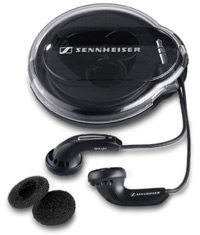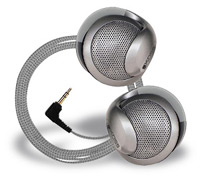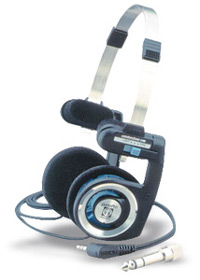Koss KSC-50, Sennheiser
MX 400, and Koss PortaPro Headphones

Sennheiser MX 400

Koss KSC-50

Koss PortaPro
|
There was a time when many people serious about
their music disdained headphones. Those cans of yore were uncomfortable, didn't reproduce
music as well as loudspeakers, and couldn't be worn unless they were clamped on your head
while you sat staring at your receiver and the etchings on your walls. Today's
lightweight, portable 'phones have changed that disdain into addiction for many folks.
They can't imagine not listening to Nirvana's Nevermind, for instance, on long
walks in the park, while playing sports, or shopping.
Headphones have come a long way, baby, and it's time to
start treating them as significant, often indispensable, components of the music-listening
experiences we enjoy. To that end, we're going to take a look at three headphones, all at
or under $30 USD, that might well serve your needs while on the go: the Koss KSC-50,
Sennheiser MX 400, and the Koss PortaPro.
The acid test: loudspeakers vs. headphones
Before we begin to assess the pros and cons of each, let's
think about the process of buying 'phones that will suit your purposes. Buying headphones
is a lot like buying loudspeakers. The most important consideration with both is value.
Are you getting your money's worth? Other factors to consider include the quality of sound
the 'phones deliver: are your music's highs, lows, and midrange being faithfully
reproduced? Last, but certainly not least, we'll weigh the appearance and comfort of the
headphones.
Another thing to consider when buying 'phones: They have
built-in limitations. The three headphones we're reviewing here cannot give you the
same aural pleasures as your set of speakers at home. These headphones present listeners
with a set of circumstances very unlike those presented by speakers, making the two
listening experiences something of a comparison between apples and oranges. Loudspeakers
generate tiny waves of air, perceived by you as sound, that travel through at least a few
feet of space before arriving at your listening position. In other words, they send sound
to you in much the same way sound occurs naturally. If a tree falls in the forest and
you're the only one nearby, you hear the sound after its traveled and after it has
interacted with other trees, the ground, plants, wildlife, etc. Some of the flora and
fauna absorb sound waves, others reflect them; all of them slightly alter the sound of the
tree falling.
Because headphones put a pair of speakers right on your
head, there is very little space between the source of sound and your ears. So there's
little travel time and minimal reflection or absorption of sound (the 'phones' earpads,
grilles, foam inserts, and the contours of your ears do cause some changes in sound).
See me, feel me
It's time to take a close look at our three inexpensive
portable headphones. First up is the Koss KSC-50, which retails for $19.95. These
lightweight, silver-and-black 'phones are designed "for travel or active use,"
according to Koss. Two small, silver circles envelop your ears when you slip on the
plastic silver-gray sportsclips. (Sportsclips are curved pieces of plastic attached
directly to each earcup, which wrap behind the ear to hold the 'phones in place,
eliminating the necessity of a headband.) Each stylish convex earcup has hundreds of tiny
holes in it (more on these later), giving them an understated 2001: A Space Odyssey
look.
Unfortunately, the hard plastic sportsclips are probably
more suited to HAL, the computer in 2001, than Dave, his human rival. Because the
clips aren't pliable or covered with a soft material of any sort, listener fatigue can set
in pretty quickly. Also, they simply didn't fit very well on my ears (such as they are).
They didn't hold the speakers close enough for my tastes and they have a tendency to pinch
a bit. Lest you think I might have Mr. Spock-like ears, I asked my significant other to
try 'em on, too. She and her beautifully shaped, alabaster ears reported similar
discomfort. This doesn't mean that they won't be perfectly comfy on your head. If
you can find an audio shop with a wide selection of 'phones, see if they'll let you try on
a variety of headphones before buying. Naturally, this will also afford you the
opportunity to audition the 'phones as well.
Sennheiser's MX 400 earbuds go for $12.95 and aren't
much to look at, but that's probably because, like all earbuds, the tiny speaker is in a
bud that fits right in your ear canal. Still, the little bit that protrudes from your ear
is a demure black and silver.
The buds are all plastic, making them a bit less than truly
comfortable, though overall they cause less discomfort than the KSC-50s. One thing to be
aware of when using earbuds is the buildup of unsightly earwax. Be sure to clean them
regularly so that the tiny vents funneling music into your ear canals don't get blocked.
The Koss PortaPro is, by far, the most pleasurable of the
three to wear. At $29.95, they're also the most expensive of the trio. They look the most
like traditional headphones, with an adjustable, flat metal band that fits across the top
of your head, small earpads covered with a soft foam, and small but thick, comfy foam pads
about an inch above the earpads. These cushions keep the earpads from clamping down on
your head too hard. The result is that the earpieces fit snugly and comfortably. They,
too, have a silver-and-black motif, with a round, baby-blue plastic panel behind the
drivers.
Hear me
The most important component of purchasing audio equipment,
after price considerations are taken into account, is making sure that you're getting
quality sound. As noted above, none of these headphones being reviewed are likely to
reproduce sound to rival that of your speakers in your listening room. None deliver sound
that competes with the nuanced depth of my reference Sennheiser HD 600 cans either.
Then again, a pair of HD 600s cost between $300 and $450, so one can't realistically
expect 'phones costing a small fraction of that to deliver such accurate highs and fat
bottoms.
What the Koss KSC-50s do deliver might surprise you: a
midrange that's fairly smooth and coherent, and enough bass to satisfy a lot of the
citizens of the hip-hop nation. I'm not part of that particular tribe, so I auditioned the
KSC-50 with the remixed, remastered Yellow Submarine [Capitol 243-5-21481-2] by the
Beatles. There was a bit of excessive sibilance displayed by the KSC-50 in John Lennon's
snarling vocals on "Hey Bulldog" and a profusion of brightness in the strings
leading off "Eleanor Rigby." However, Paul McCartney's sad, soothing vocals on
the latter are reproduced without much coloration and George Harrison's delicate guitar
riffs on the former are a bit lean, but not unpleasantly bony.
The KSC-50s really shone when having DCC's gold-disc
version of Bonnie Raitt's Nick of Time (DCC GSC-1099) pumped through 'em. That
might well be because most of this album sticks to the midrange in which the 50s are most
adept. Raitt's worn, husky voice caresses rather than pierces and the 50s stayed right
with her, putting Bonnie's voice agreeably inside my head. Hutch Hutchinson's pleasant
rumblings on bass on "Love Letter" and other tunes aren't extended as far down
as one might hope, but they're reproduced with an acceptable level of accuracy.
You can hardly go wrong with the Koss KSC-50s. They're only
20 bucks; for that, they'll make your running, shopping, and hip-hopping worthwhile
musical adventures. For those sorts of activities, you generally need good, not great,
sound and that's what you can expect from these 'phones. One other note: Remember those
holes in the earpieces we mentioned earlier? You're going to get sound bleeding in and out
of those, so if you don't want to hear outside noise or you don't want to bother those
near you with your tunes, these aren't the 'phones for you.
If you audition the KSC-50s and find that they're a bit too
bright, then you shouldn't bother trying out the Sennheiser MX 400s. They're even
brighter, though even in that sonic light, you can hear details in the upper end that 20
years ago no one would've thought imaginable from two tiny buds snugged into ears.
A lot of people thinking about buying earbuds are concerned
with just how low they can go. So I popped The Best of Con Funk Shun [Mercury 31458
68232] into the reference NAD C521i CD player and let the '70s wash all over me in shades
of avocado and burnt orange. The bass-heavy funk-jam "Chase Me" was still a good
time to listen to, but the low end definitely lacked slam and its highs were overly
bright.
The Sennheiser MX 400s are the least expensive of
these three 'phones, as well as the lightest, and like most earbuds, they block out
ambient noise and allow you to focus on your music. If you're looking for cheap buds with
a bit of punch, that won't make you cry if you lose 'em, these will do nicely.
When the Koss PortaPros took on Con Funk Shun, suddenly
plenty of aural booty was to be found. The lows camouflaged by the Sennheisers abruptly
blossomed and boogied. Sure, they weren't as low as you're likely to hear from your home
system, but they're as accurate, deep, and immediate as you're likely to find at this
price point.

Koss PortaPro Headphones
|
The midrange and highs shouldn't be overlooked either. Both
are dynamic and detailed, though as with the other two sets of headphones, imperfect. The
very top ends are a bit metallic sounding, but at this price, that's to be expected. These
'phones, like the other set from Koss, also allow sound in and out, so factor that into
your buying decision.
Buy me
Our strongest recommendation goes to the Koss PortaPros.
They're by far the best value in this bunch. Not only do they sound the best, they're also
the most comfortable to wear. They're as close to a home-system listening experience as 30
bucks is likely to get you.
The Sennheiser MX 400s and Koss KSC-50s might be
perfectly suited to your needs, however. At their prices, you won't be maxing out your
plastic if you buy either or both.Note: All three headphones can be driven by portable
listening devices such as CD players. None requires a separate headphone amp.
The reviewed headphones are available at HeadRoom.
Prices of equipment reviewed
|